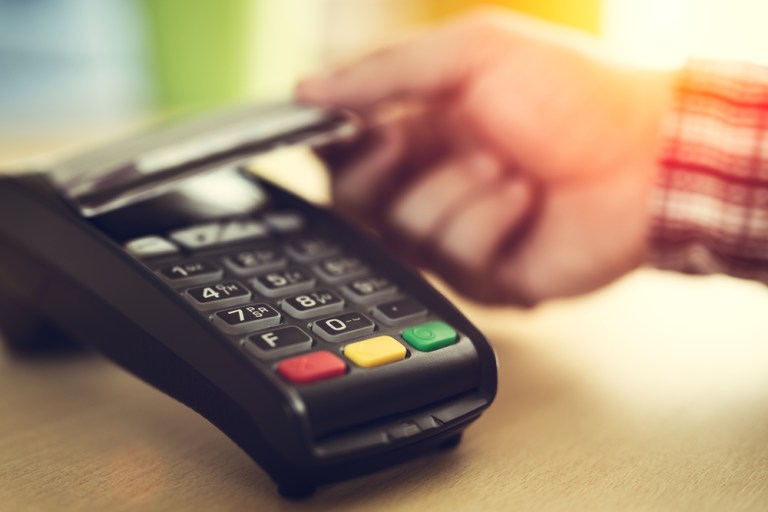
To that end, Chase, the largest card issuer in the U.S., said Wednesday (Nov. 14) that it’s rolling out tap-to-pay functionality across its Chase Visa card portfolio. The rollout will be in stages, spanning from the end of 2018 into 2019, as customers open new accounts or as their cards are renewed, starting with credit cards — debit cards will join the contactless pantheon in the latter half of 2019.
The effort is broad and far-reaching, considering how more than 90 million debit and credit cards are wielded by Chase customers across the United States.
In an interview with Karen Webster, Abeer Bhatia, president of Chase Cards Services, said the overarching goal with tap-and-pay, and the eventual enablement of that functionality across all Chase Visa cards, is to “let consumers pay the way they want to pay.” The statement gives a nod to the fact that using a plastic card has become a way of life, a form factor for payments with which consumers are intimately familiar.
The move toward tap-to-pay is, of course, gathering steam. Consider the findings from PYMNTS’ second annual “How We Will Pay” report, done in collaboration with Visa, issued earlier this month. A survey of 2,800 consumers found that many individuals have the desire to tap and pay, rather than swipe cards at the point of sale (POS). As many as 65 percent said they would be interested in adopting contactless payments because they are “faster” (more on this in a minute), while 60 percent said they’d do so for the convenience factor. A majority said they would like to use contactless at physical stores, and 84 percent said they see grocery shopping as the predominant use case, followed by pharmacies and quick-service restaurants (QSRs).
In terms of other hard data, Visa noted that 40 percent of its own transactions done outside the United States are done through tap-and-pay means. In the U.S., 70 of the top 100 merchants, as measured by transaction count, offer the ability to pay using tap-at-checkout. Visa said in remarks on its most recent earnings call that more than half of all in-person transactions in the U.S. occur through contactless-enabled terminals.
Bhatia said the Chase/Visa rollout will domestically feature an “experience that is very similar to the one that consumers have outside the U.S. market, which is pretty popular,” as proven by markets as far-flung as the U.K., Australia and Canada. In the U.K., he said, contactless payments now account for a significant number of London Tube journeys, only a few years after introduction.
It Can Happen Here
When asked by Webster if the U.S. is reaching an inflection point where tap-to-pay may become more widely adopted, Bhatia said the very concept of tapping to do any manner of things has become more entrenched in everyday life. U.S. consumers, he said, are “very used to using a plastic card to tap to gain access to buildings, or to transit systems like the PATH train between New York City and New Jersey. Tapping the plastic card is much more familiar than some other form factors.”
The aforementioned 70-of-100 top merchants offering tap-to-pay in the U.S. — spanning use cases across grocery shopping, pharmacies and QSRs — indicate that the time is ripe for tap-and-pay cards to be introduced through Chase and Visa. The pump has been primed, in part, as merchants upgraded in the wake of EMV to new terminals that can take transactions via chip cards.
In some ways, it has also been primed by consumers, who routinely approach checkout with mobile phones in hand, only to produce a card to pay for their purchases. Using mobile devices as a contactless form factor has struggled to gain momentum — the “How We Will Pay” report found that only a high single-digit to mid-teens percentage of transactions are done that way.
Bhatia is confident that the tap-to-pay rollout won’t come with the same speed bumps that have marked contactless mobile payments so far. It wasn’t the contactless technology that consumers didn’t embrace, but the change in form factor: the uncertainty of acceptance combined with the trust that consumers have in their cards, knowing that they will work virtually anywhere. Should a consumer find themselves at a terminal that does not take contactless payments, the option is, of course, to dip the card.
“The card the consumer has in [their] hand will work, one way or another,” he said.
Beyond the convenience factor of being able to pay at the POS no matter what the technological limitations may be, Bhatia noted the speed of tap-and-pay, stating that “the payment itself is about 60 to 70 percent faster.”
“‘Cool’ is one way I can describe tap-and-pay,” he told Webster, “and convenient and easy and secure are other ways I can describe it.”
When questioned about near term goals for the rollout, Bhatia said that “by the end of January, we expect about 10 million Chase cards to be contactless.”